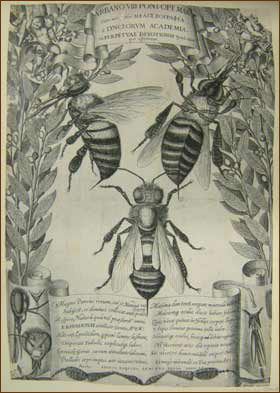Engraving prepared with the help of a microscope

Although there is some doubt as to who invented the simple microscope, credit for the invention of the first compound microscope incorporating two lenses is usually given to the Dutch spectacle makers Hans Janssen and his son Zacharias around the year 1590. By the early 17th century the compound microscope was beginning to be accepted and regularly used by members of the 'Academy of the Lynx' in Rome, one of the first scientific societies whose members included Galileo.
In 1618 Francesco Stelluti and other members of the Academy used a compound microscope to produce enlarged drawings of bees. Subsequently, in 1625 there appeared a single sheet containing Matthaeus Greuter's magnificent engraving from these drawings.
There are only three other known copies – in the Lancisiana Library, Rome, the Marucelliana Library, Florence, and the Biblioteca Universitaria, Pisa.
Image: 'Melissographia'. Rome, 1625. [NLS shelfmark: MRB.233]